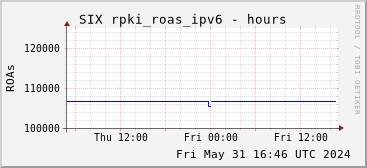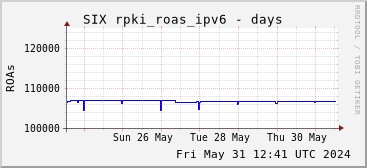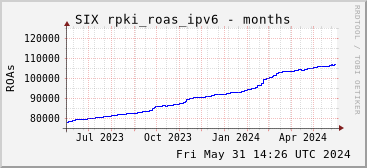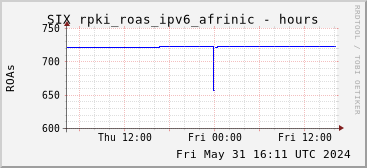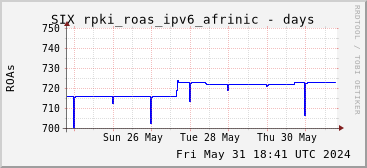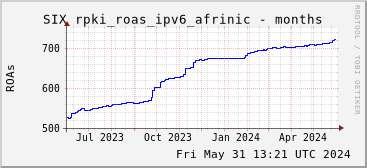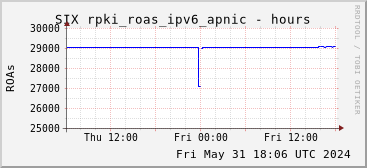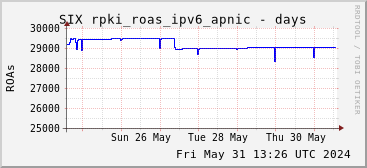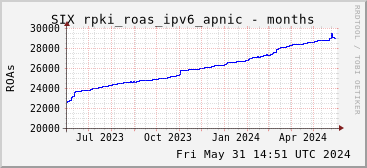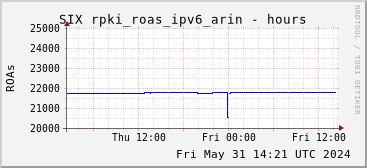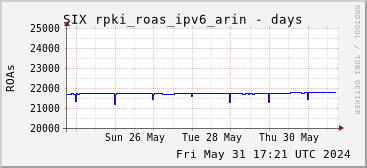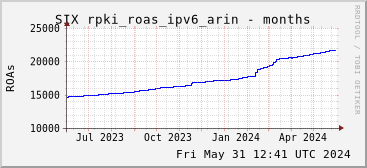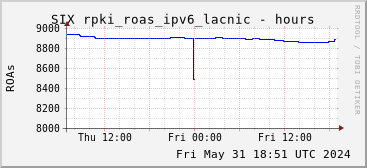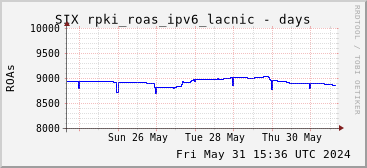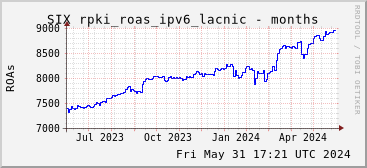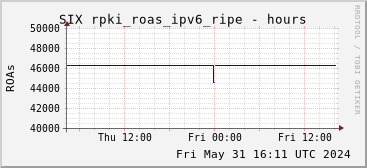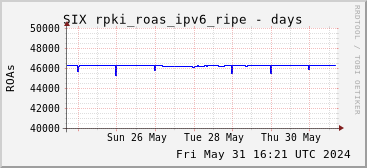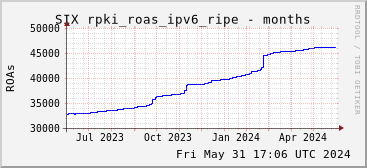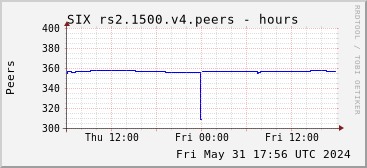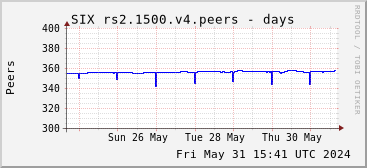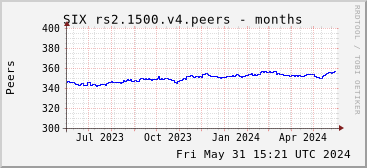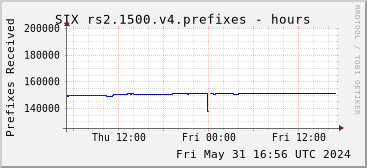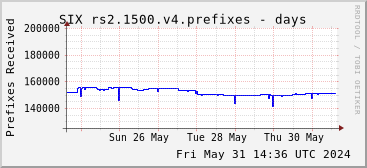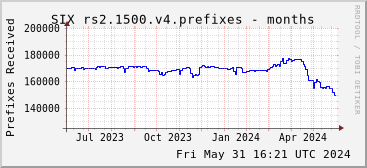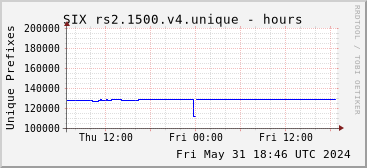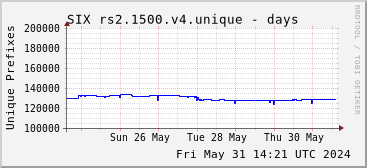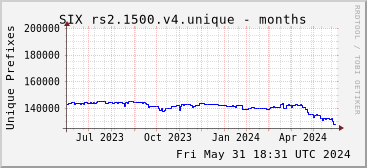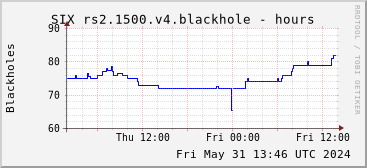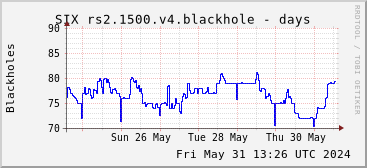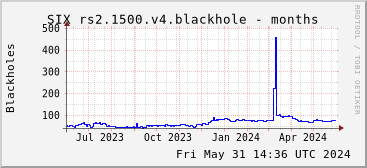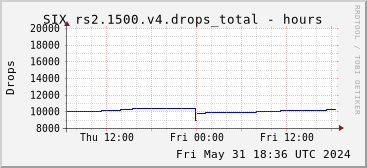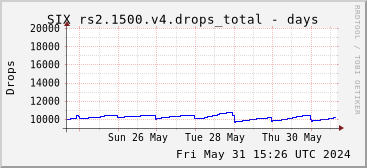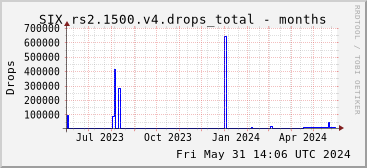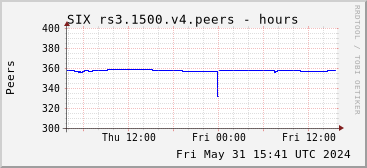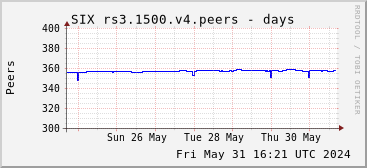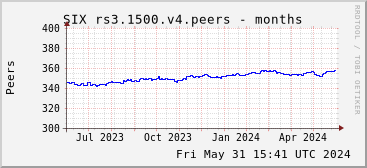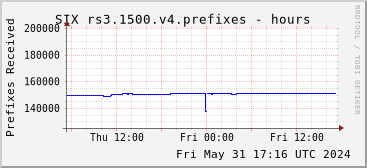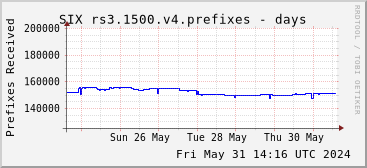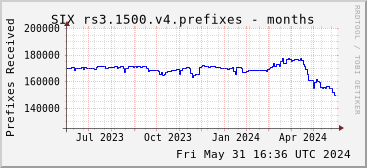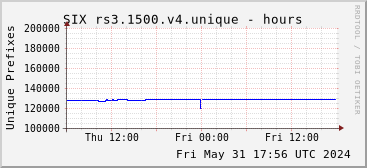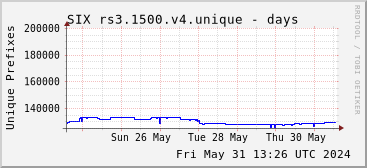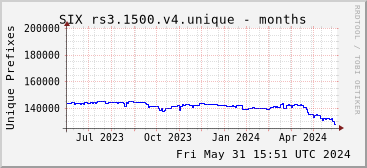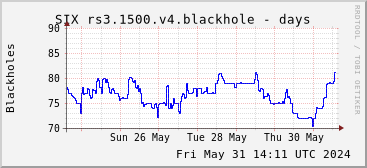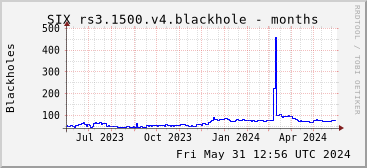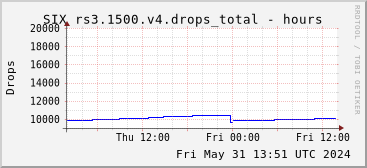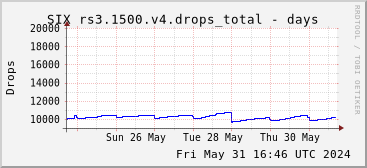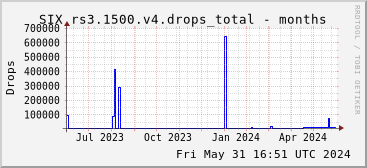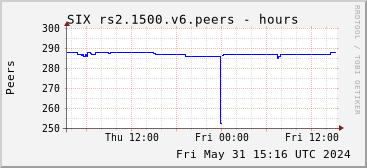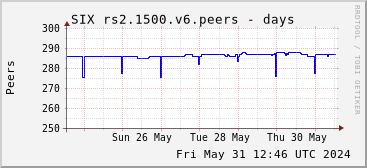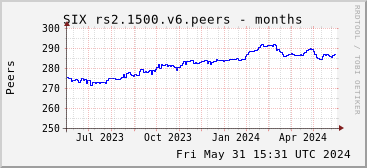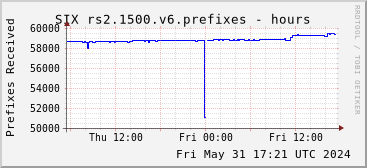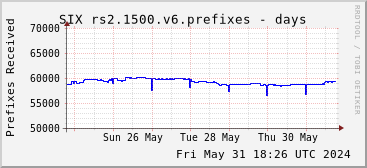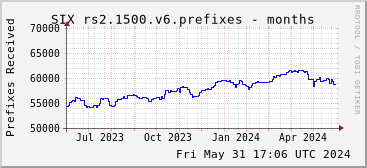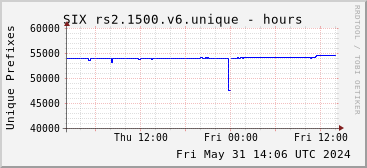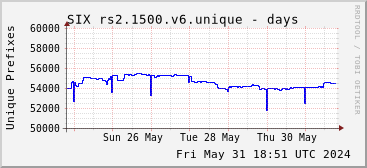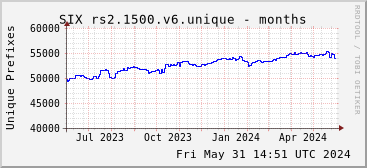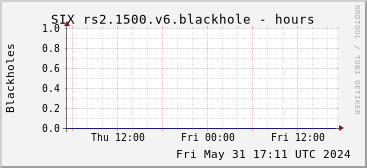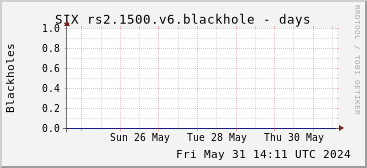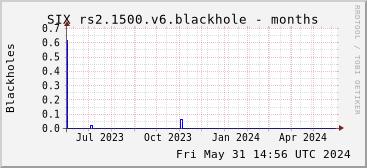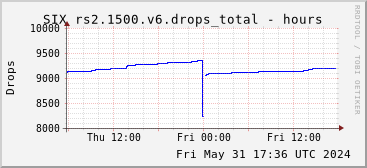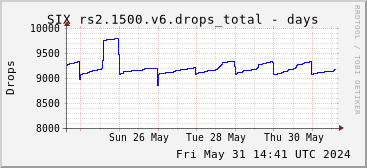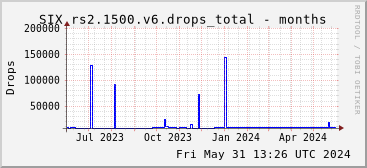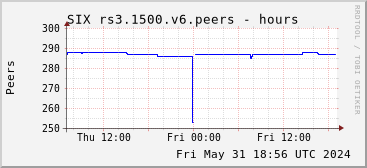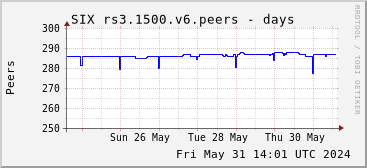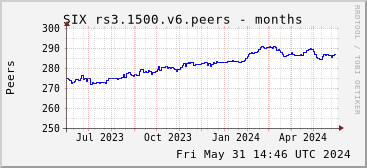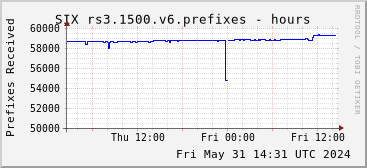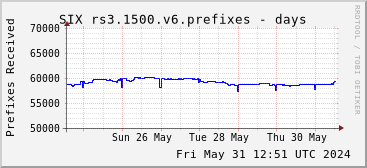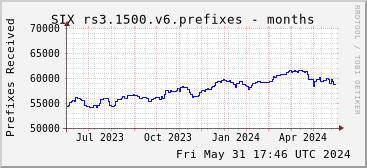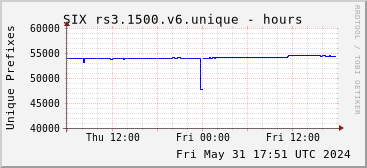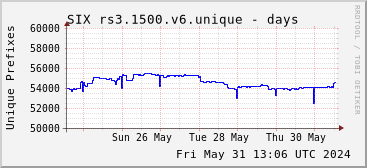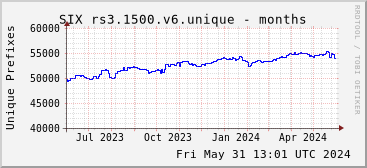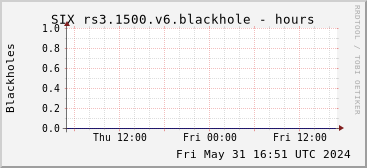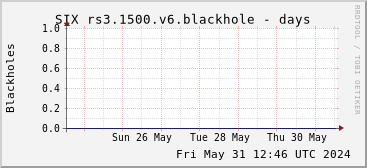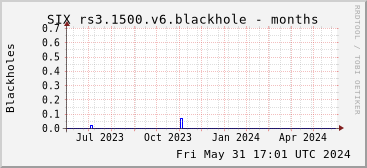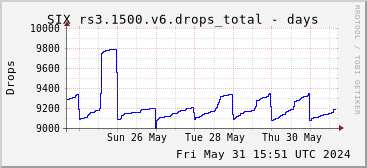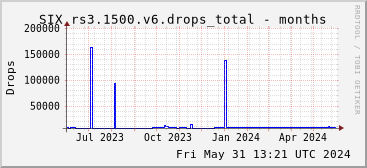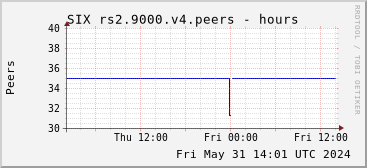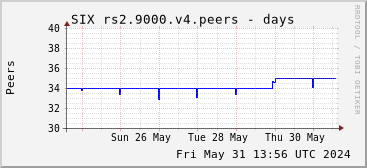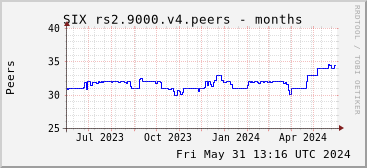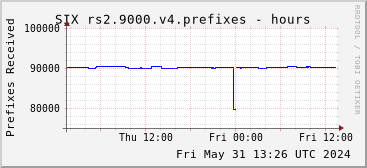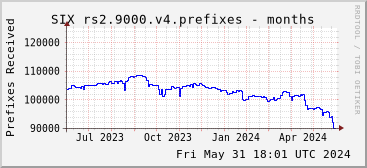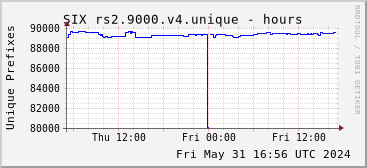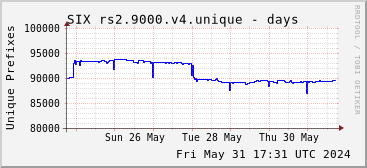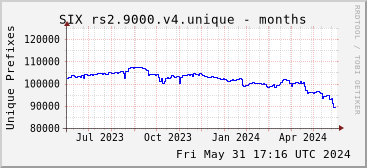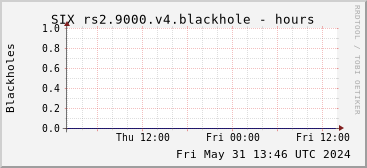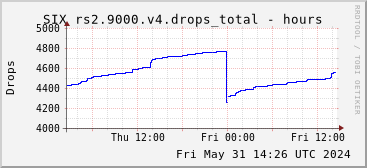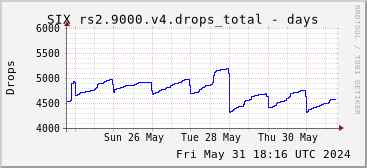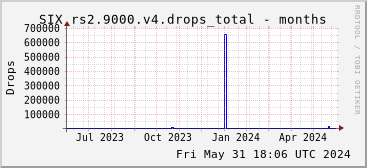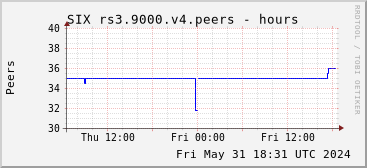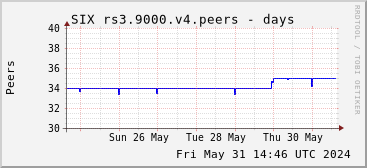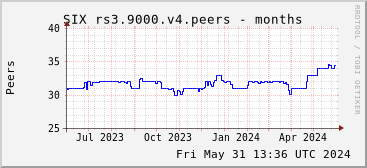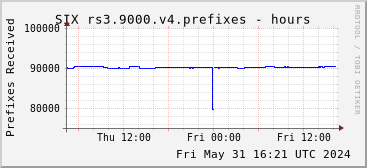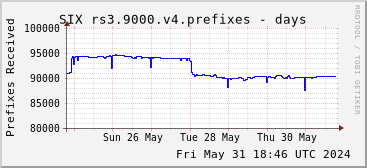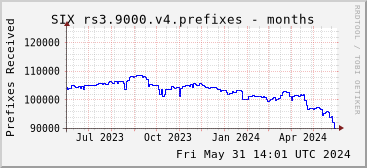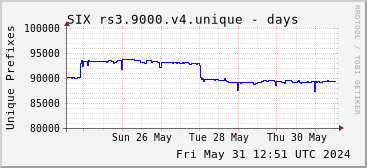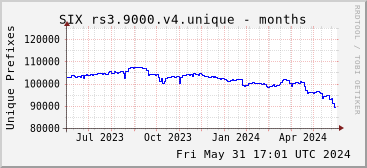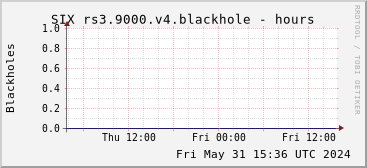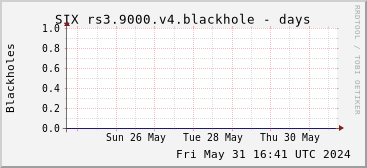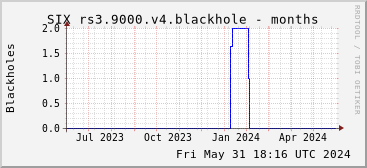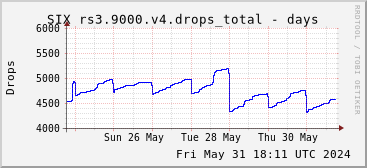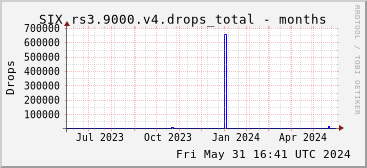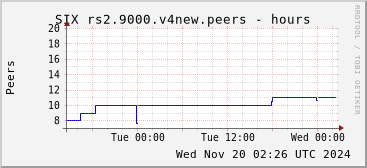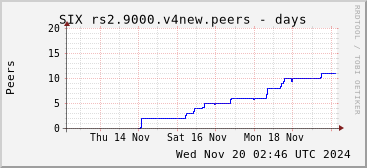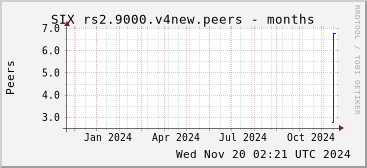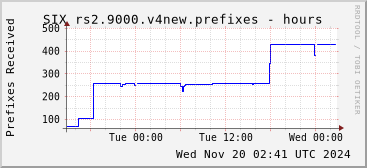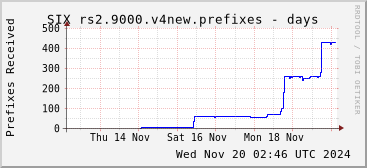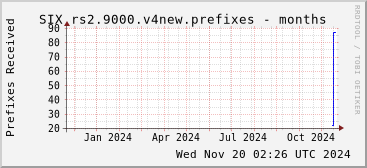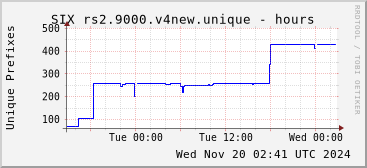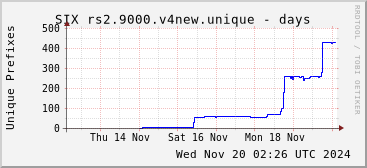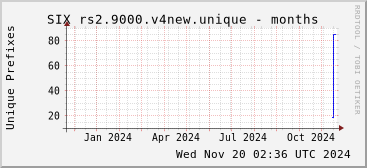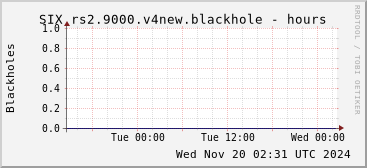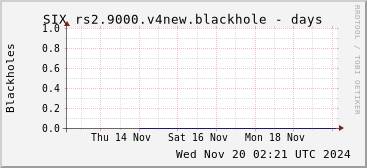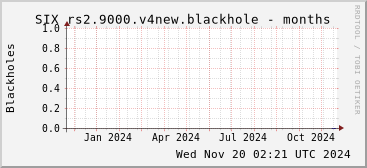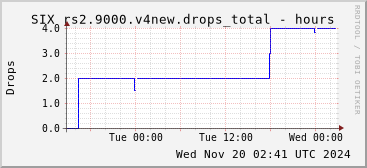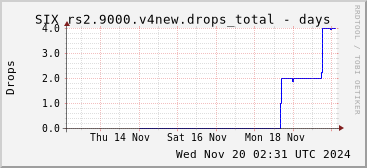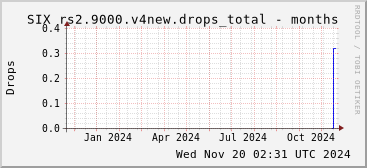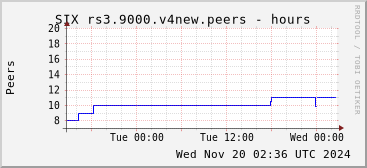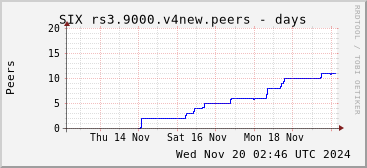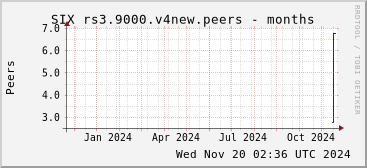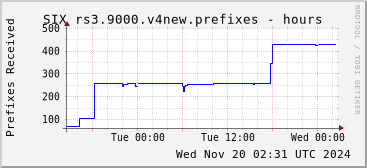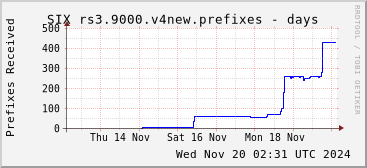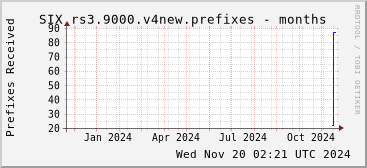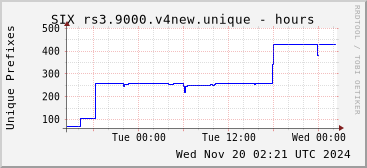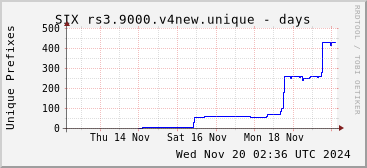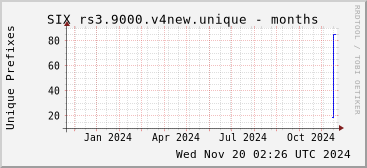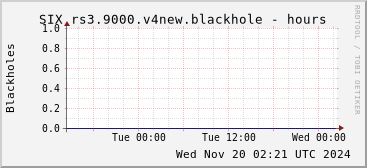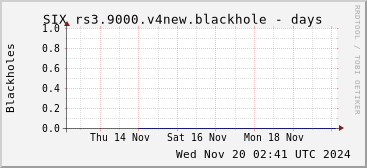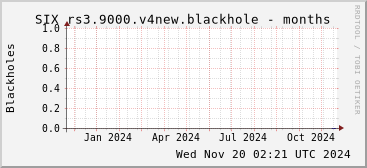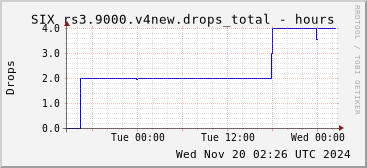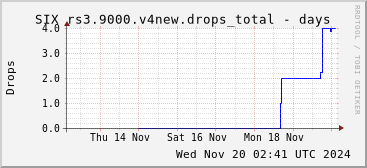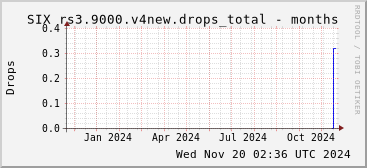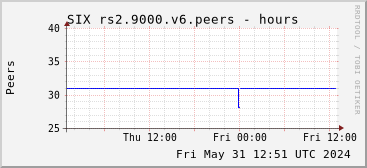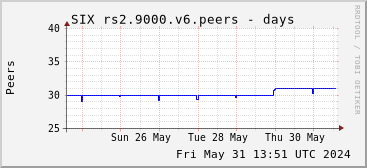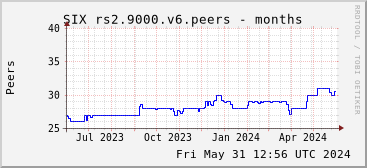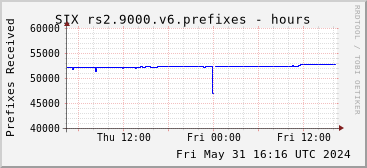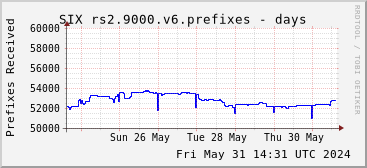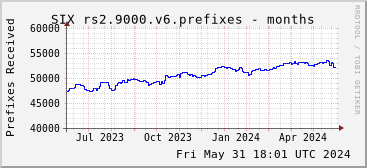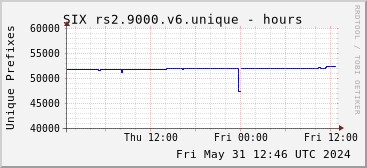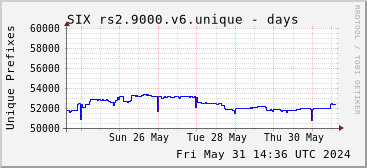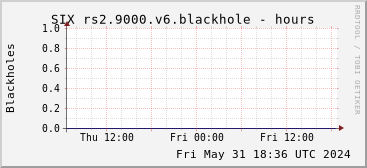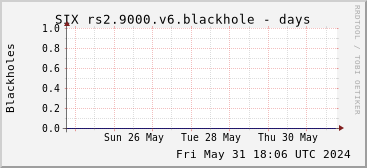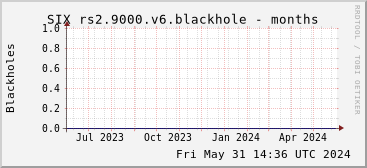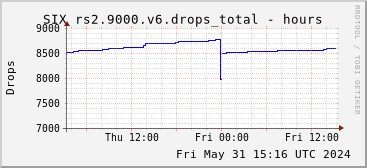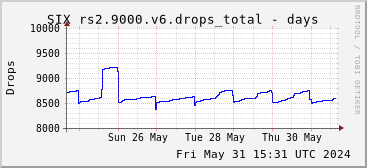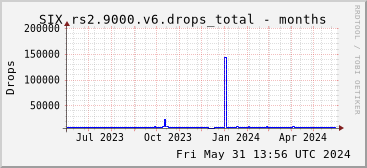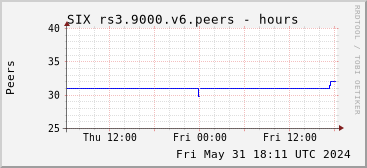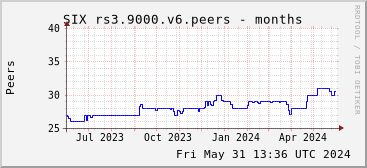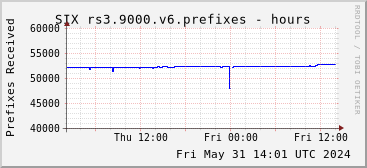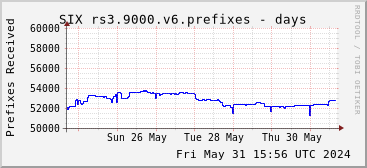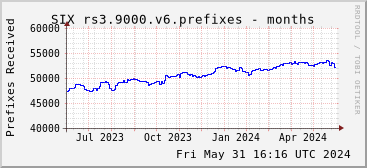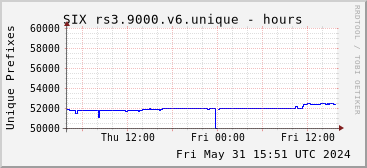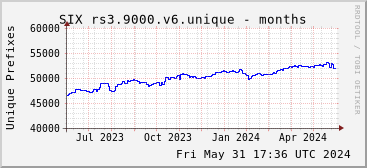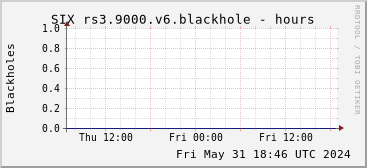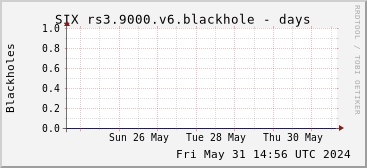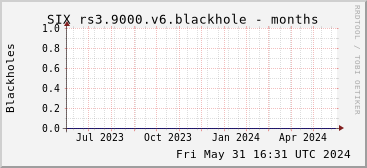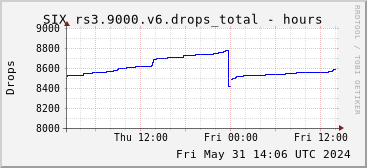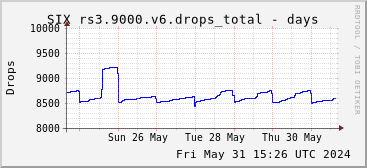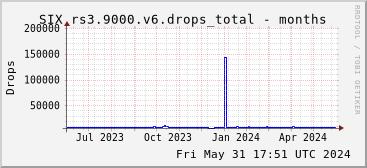Route server details:
- General information on route servers is at AMS-IX Route Servers.
- The SIX ASN is 33108.
- Max prefix for IPv4 and IPv6 comes from your ASN's PeeringDB record. For your peering, if you use a max prefix with the route server, we recommend 200,000 for IPv4 routes and 70,000 for IPv6 routes. The AS-SET representing all participants at the SIX is AS-SEATTLEIX-RS-CLIENTS.
- IPv4 routes shorter than /8 are filtered and IPv6 routes shorter than /19 are filtered. Bogon ASNs and martian prefixes are filtered.
- Strict filtering is performed using Internet Routing Registry (IRR) data. IRR Explorer may also be useful. You can verify your IRR data with:
IPv4 prefixes: whois -h rr.ntt.net '!gasYOUR_ASN_NUM' IPv6 prefixes: whois -h rr.ntt.net '!6asYOUR_ASN_NUM' AS-SET ASNs: whois -h rr.ntt.net '!iYOUR_AS_SET_NAME,1' AS-SET IPv4 prefixes: whois -h rr.ntt.net '!a4YOUR_AS_SET_NAME' AS-SET IPv6 prefixes: whois -h rr.ntt.net '!a6YOUR_AS_SET_NAME'
The route servers update from the IRR about once per hour. We mirror the following databases: AFRINIC, ALTDB, APNIC, ARIN, BBOI, BELL, CANARIE, IDNIC, JPIRR, LEVEL3, NTT-RPKI (synthesized), NTTCOM, RADB, REGISTROBR (synthesized), RIPE, RIPE-NONAUTH, TC - The route servers also utilize Resource Public Key Infrastructure (RPKI) data and update hourly. If an ROA exists for a prefix and the route servers receive an announcement in violation, it will be dropped. At the SIX, an RPKI ROA replaces the need for an IRR route/route6 object. An IRR as-set remains needed for downstream ASNs.
- The route servers also honor the choice of all networks with respect to the PeeringDB option 'Never via route servers'.
- The route servers are configured to be BGP-passive thus your side needs to be BGP-active. If you have a PeeringDB record and IRR records, you are ready to peer with the SIX route servers. Your PeeringDB "IRR as-set/route-set" should contain simply your IRR as-set name. The route servers use this information. (Email info_a_t_seattleix.net if your as-set is not being recognized, for special handling.)
- IRR Setup tutorial. We recommend you create RPKI and IRR records at the Regional Internet Registry (RIR) which assigned/allocated your address space.
- The route server service is intended to supplement, not replace your direct peering. If you have a peer you value, take the time to establish direct peering.
- It is important to establish sessions with all of the route servers available on the VLANs to which you are attached, so that maintenance on one route server does not affect your connectivity.
- The communities specified in the table below may be used to control the propagation of your routes. In addition, the RFC 7999 BLACKHOLE community 65535:666 is supported. See our blackholing page for additional details.
- The route server software is BIRD. Much appreciation to the BIRD team.
- BGP passwords (RFC 2385) are not supported.
- Per RFC 7911 "Advertisement of Multiple Paths in BGP", the SIX route servers are configured to transmit multiple path information, but not receive more than one path per peer. This means that your router will only be able to send a single path per peer for a given prefix to the route servers, but if the route servers receive a path from multiple peers, all of them will be shared with other peers who have opted-in per RFC 7911.
- Jumbo VLAN participants: You may want to prefer the jumbo VLAN for equal paths received from both VLANs. One way to do this is with MEDs (external metric) since that will not override AS path selection.
- Write to info_a_t_seattleix.net to trunk your circuit to gain access to the Jumbo VLAN.
- A looking glass for prefixes sent to the route servers is available for each participant at the participants page, including the reasoning behind any prefixes dropped by the filters. Data may be a minute or two old. The error files listing dropped prefixes are reset daily UTC.
- The route server drops analysis page provides comprehensive details on SIX route server filtering statistics by rule, charts, and BIRD pseudocode to show how filtering is performed. A specific ASN can also be focused on, reachable from the participants page if you have errors indicated, or by adding "?asn=#" to the URL (replace # with an ASN).
- An IPv4 Hilbert Curve map of unique prefixes announced to the rs2 MTU 1500 route server is here. Blue = available via route servers, Light blue = available but likely government and not really reachable, Gray = IANA reserved. Code at: https://github.com/bradfitz/sixmap
Route server list:
| VLAN (MTU) | Protocol | Server | Address | Peers | Prefixes Received | Unique Prefixes | Blackholes | Drops | Status |
|---|---|---|---|---|---|---|---|---|---|
| Standard (1500) | IPv4 | rs2 | 206.81.80.2 | ||||||
| " | " | rs3 | 206.81.80.3 | ||||||
| " | IPv6 | rs2 | 2001:504:16::2 | ||||||
| " | " | rs3 | 2001:504:16::3 | ||||||
| Jumbo (9000) | IPv4 | rs2 | 206.81.82.2 | ||||||
| " | " | rs3 | 206.81.82.3 | ||||||
| " | " | rs2 | 149.112.96.2 | ||||||
| " | " | rs3 | 149.112.96.3 | ||||||
| " | IPv6 | rs2 | 2001:504:16:1::2 | ||||||
| " | " | rs3 | 2001:504:16:1::3 |
Route server example peer configs:
JunOS:
"configuration protocols bgp"
group six-rserver2 {
type external;
neighbor 206.81.80.2 {
description "ipv4 SIX-rserver2";
family inet {
unicast {
prefix-limit {
maximum 200000;
}
}
}
peer-as 33108;
}
}
group six-rserver3 {
type external;
neighbor 206.81.80.3 {
description "ipv4 SIX-rserver3";
family inet {
unicast {
prefix-limit {
maximum 200000;
}
}
}
peer-as 33108;
}
}
group v6six-rserver2 {
type external;
neighbor 2001:504:16::2 {
description "ipv6 SIX-rserver2";
family inet6 {
unicast {
prefix-limit {
maximum 70000;
}
}
}
peer-as 33108;
}
}
group v6six-rserver3 {
type external;
neighbor 2001:504:16::3 {
description "ipv6 SIX-rserver3";
family inet6 {
unicast {
prefix-limit {
maximum 70000;
}
}
}
peer-as 33108;
}
}
IOS:
no bgp enforce-first-as ! neighbor SIX-peer maximum-prefix 200000 neighbor v6SIX-peer maximum-prefix 70000 ! neighbor 206.81.80.2 remote-as 33108 neighbor 206.81.80.2 peer-group SIX-peer neighbor 206.81.80.2 description six_rs2 ! neighbor 206.81.80.3 remote-as 33108 neighbor 206.81.80.3 peer-group SIX-peer neighbor 206.81.80.3 description six_rs3 ! neighbor 2001:504:16::2 remote-as 33108 neighbor 2001:504:16::2 peer-group v6SIX-peer neighbor 2001:504:16::2 description six_rs2 ! neighbor 2001:504:16::3 remote-as 33108 neighbor 2001:504:16::3 peer-group v6SIX-peer neighbor 2001:504:16::3 description six_rs3
IOS-XR:
neighbor 206.81.80.2
remote-as 33108
use neighbor-group SIX
description six_rs2
enforce-first-as disable
address-family ipv4 unicast
maximum-prefix 200000 restart 30
!
neighbor 206.81.80.3
remote-as 33108
use neighbor-group SIX
description six_rs3
enforce-first-as disable
address-family ipv4 unicast
maximum-prefix 200000 restart 30
!
neighbor 2001:504:16::2
remote-as 33108
use neighbor-group SIXv6
description six_rs2
enforce-first-as disable
address-family ipv6 unicast
maximum-prefix 70000 restart 30
!
neighbor 2001:504:16::3
remote-as 33108
use neighbor-group SIXv6
description six_rs3
enforce-first-as disable
address-family ipv6 unicast
maximum-prefix 70000 restart 30
Route server communities. These are processed by the route servers and not propagated. Unless prevented by a community, routes will be propagated to other route server peers. (For extended communities, ro == so == soo.):
| Evaluation Order | Standard | Extended | Large | Action |
|---|---|---|---|---|
| 1 | 33108:0:peer-as | Do not advertise to peer-as | ||
| 2 | 33108:1:peer-as | Advertise to peer-as | ||
| 3 | 33108:0:0 | Do not advertise to any peer | ||
| 4 | 0:peer-as | ro:0:peer-as | Do not advertise to peer-as | |
| 5 | 33108:peer-as | ro:33108:peer-as | Advertise to peer-as | |
| 6 | 0:33108 | ro:0:33108 | Do not advertise to any peer | |
| N/A | 65001:peer-as | ro:65001:peer-as | 33108:65001:peer-as | Prepend 1 time to peer-as |
| N/A | 65002:peer-as | ro:65002:peer-as | 33108:65002:peer-as | Prepend 2 times to peer-as |
| N/A | 65003:peer-as | ro:65003:peer-as | 33108:65003:peer-as | Prepend 3 times to peer-as |
rs2 1500 MTU IPv4:
rs3 1500 MTU IPv4:
rs2 1500 MTU IPv6:
rs3 1500 MTU IPv6:
rs2 9000 MTU IPv4 206.81.82.2:
rs3 9000 MTU IPv4 206.81.82.3:
rs2 9000 MTU IPv4 149.112.96.2:
rs3 9000 MTU IPv4 149.112.96.3:
rs2 9000 MTU IPv6:
rs3 9000 MTU IPv6:
RPKI IPv4 ROAs in total and by RIR
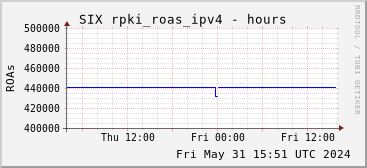
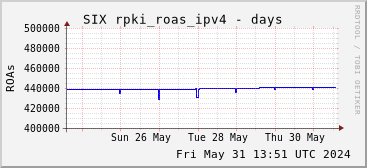
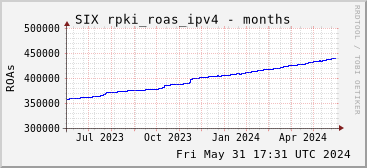
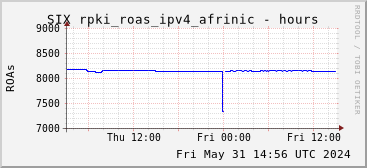
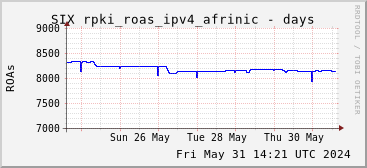
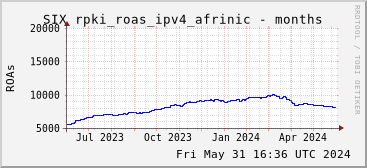
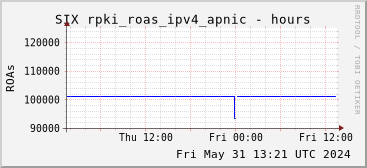
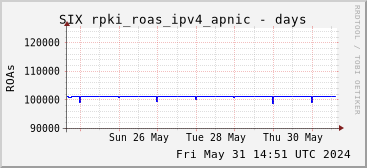
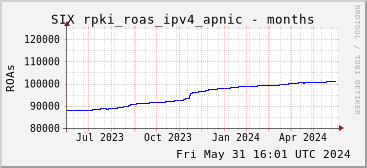
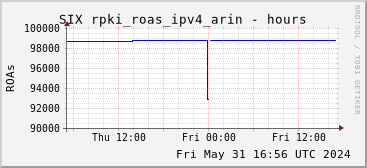
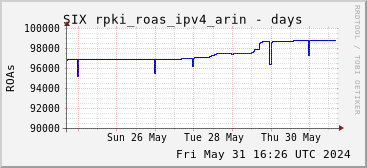
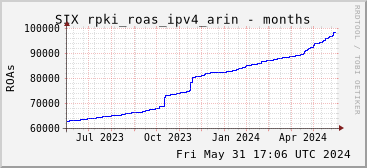
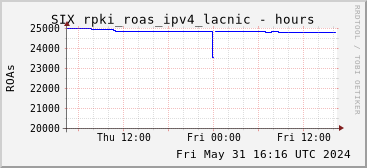
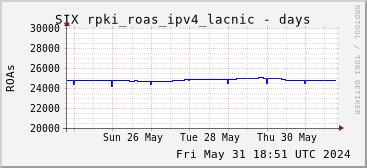
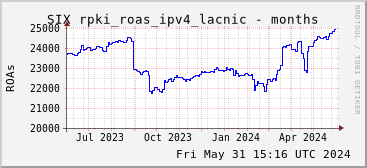
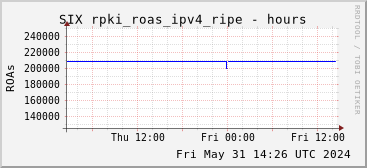
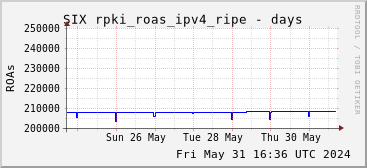
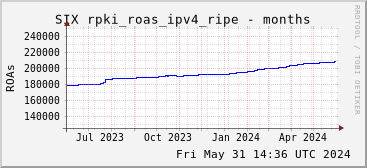
RPKI IPv6 ROAs in total and by RIR
